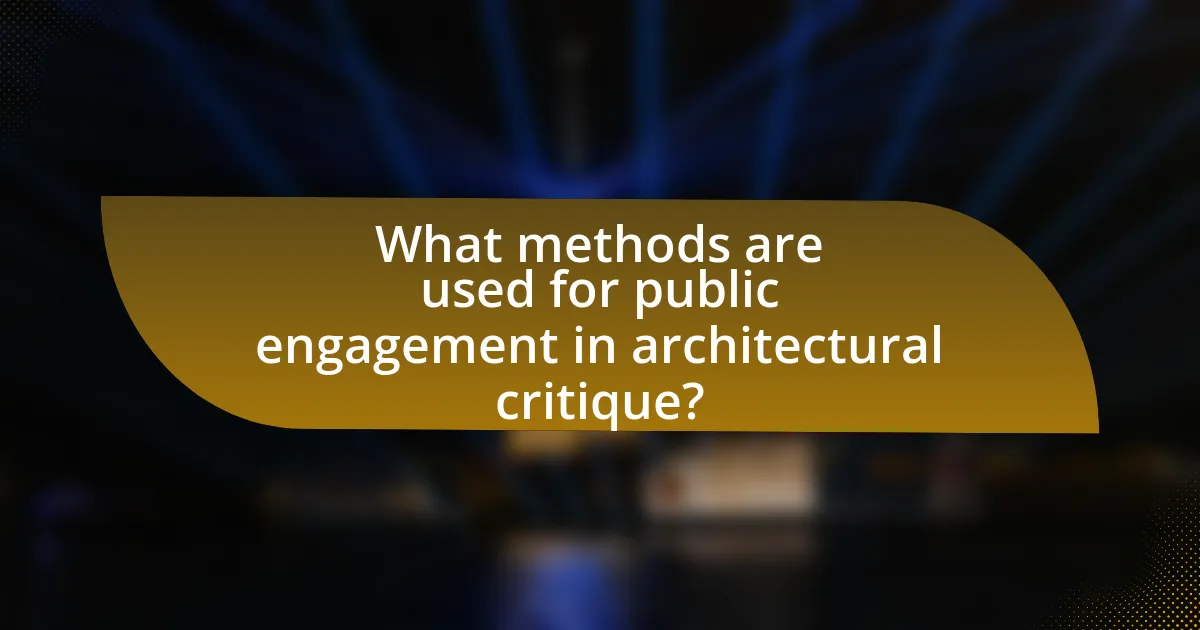The article examines the critical role of public engagement in architectural critique, emphasizing its importance in fostering dialogue between architects, stakeholders, and the community. It outlines how public involvement enhances architectural design by incorporating diverse perspectives, leading to greater community satisfaction and ownership of projects. Key elements of effective public engagement include transparency, accessibility, and feedback mechanisms, which collectively improve the quality of architectural outcomes. The article also discusses methods for facilitating public participation, the challenges faced in engaging the public, and the positive impacts of community input on architectural design and sustainability.

What is the Role of Public Engagement in Architectural Critique?
Public engagement plays a crucial role in architectural critique by facilitating dialogue between architects, stakeholders, and the community. This interaction allows for diverse perspectives to be considered, ensuring that architectural designs meet the needs and values of the public. Research indicates that projects with high levels of public involvement often result in greater community satisfaction and support, as seen in the case of the participatory design processes employed in urban redevelopment projects. Such engagement not only enhances the quality of architectural outcomes but also fosters a sense of ownership and responsibility among community members, ultimately leading to more sustainable and accepted architectural solutions.
How does public engagement influence architectural critique?
Public engagement significantly influences architectural critique by incorporating diverse perspectives and fostering community involvement in the evaluation of architectural works. This interaction allows architects and critics to understand the needs and preferences of the public, leading to more relevant and socially responsive designs. For instance, studies have shown that projects with active public participation often result in higher satisfaction rates among users, as seen in the case of the High Line in New York City, where community input shaped the design and programming of the space. This evidence illustrates that public engagement not only enriches the critique process but also enhances the overall quality and acceptance of architectural projects.
What are the key elements of public engagement in architecture?
The key elements of public engagement in architecture include community involvement, transparency, accessibility, and feedback mechanisms. Community involvement ensures that the voices of local residents are heard and considered in the design process, fostering a sense of ownership and relevance in architectural projects. Transparency in sharing project goals, plans, and progress builds trust between architects and the public, allowing for informed participation. Accessibility refers to making engagement opportunities available to diverse populations, ensuring that all community members can contribute their perspectives. Feedback mechanisms, such as surveys and public forums, allow architects to gather input and adapt designs based on community needs and preferences, ultimately leading to more successful and accepted architectural outcomes.
How does public feedback shape architectural design?
Public feedback significantly influences architectural design by providing insights into community needs and preferences. Architects often incorporate public input to ensure that designs are functional, aesthetically pleasing, and culturally relevant. For instance, community workshops and surveys allow architects to gather diverse opinions, which can lead to modifications in design elements such as building materials, layout, and accessibility features. Research conducted by the American Institute of Architects indicates that projects with robust public engagement processes tend to have higher satisfaction rates among users and stakeholders, demonstrating the effectiveness of integrating public feedback into architectural practices.
Why is public engagement important in architectural critique?
Public engagement is important in architectural critique because it fosters diverse perspectives that enhance the evaluation of architectural works. Engaging the public allows architects and critics to gather insights from various stakeholders, including community members, users, and local organizations, which can lead to more inclusive and relevant design solutions. Research indicates that projects with strong public involvement often result in higher satisfaction rates and better alignment with community needs, as seen in the case of the High Line in New York City, where community input significantly shaped its design and use. This collaborative approach not only enriches the critique process but also promotes accountability and transparency in architectural practices.
What are the benefits of involving the public in architectural discussions?
Involving the public in architectural discussions enhances community relevance and fosters a sense of ownership over local projects. Engaging the public allows architects and planners to gather diverse perspectives, ensuring that designs reflect the needs and desires of the community. Research indicates that projects with public input often experience higher satisfaction rates and better long-term success, as seen in the case of the High Line in New York City, where community involvement led to a design that prioritized public space and accessibility. This collaborative approach not only improves the quality of architectural outcomes but also strengthens community ties and promotes civic engagement.
How does public engagement enhance community identity through architecture?
Public engagement enhances community identity through architecture by fostering collaboration between architects and community members, ensuring that designs reflect local values and cultural narratives. When community members actively participate in the architectural process, their input shapes the built environment, leading to structures that resonate with their identity and history. For instance, projects like the participatory design initiatives in the Netherlands have demonstrated that involving residents in the planning stages results in buildings that embody the community’s character and aspirations, thus strengthening their sense of belonging and pride. This collaborative approach not only creates functional spaces but also reinforces social ties and collective memory, ultimately enriching the community’s identity.

What methods are used for public engagement in architectural critique?
Public engagement in architectural critique employs methods such as community workshops, public forums, online surveys, and social media platforms. Community workshops facilitate direct interaction between architects and residents, allowing for feedback and discussion on design proposals. Public forums provide a structured environment for stakeholders to voice opinions and concerns, often leading to collaborative solutions. Online surveys gather quantitative data on public preferences and perceptions, while social media platforms enable broader outreach and real-time engagement, fostering a dialogue that can influence architectural decisions. These methods collectively enhance transparency and inclusivity in the architectural critique process.
How do architects facilitate public participation?
Architects facilitate public participation by employing various engagement strategies that encourage community input in the design process. These strategies include hosting public forums, workshops, and design charrettes, where stakeholders can express their needs and preferences. For instance, a study by the American Institute of Architects highlights that involving the public early in the design phase leads to more relevant and accepted outcomes, as it allows architects to incorporate diverse perspectives and local knowledge into their projects. This collaborative approach not only enhances the design quality but also fosters a sense of ownership and connection among community members.
What tools and platforms are effective for gathering public input?
Effective tools and platforms for gathering public input include online surveys, social media, community forums, and dedicated feedback applications. Online surveys, such as SurveyMonkey and Google Forms, allow for structured data collection from a wide audience, facilitating quantitative analysis. Social media platforms like Facebook and Twitter enable real-time engagement and feedback from diverse demographics, enhancing outreach. Community forums, both physical and virtual, provide spaces for in-depth discussions and qualitative insights. Additionally, dedicated feedback applications like CitizenLab and Bang the Table are designed specifically for civic engagement, offering tailored features for public input collection. These tools have been validated by numerous case studies demonstrating their effectiveness in engaging communities and informing decision-making processes in urban planning and architectural critique.
How can workshops and forums enhance public engagement?
Workshops and forums enhance public engagement by providing interactive platforms for community members to share ideas, express concerns, and collaborate on solutions. These settings facilitate direct communication between stakeholders, allowing for diverse perspectives to be heard and considered in the decision-making process. Research indicates that participatory approaches, such as those found in workshops and forums, lead to increased civic involvement and a stronger sense of community ownership over local projects. For instance, a study by the National Endowment for the Arts found that communities engaged in participatory planning processes reported higher satisfaction with public spaces and services. This evidence underscores the effectiveness of workshops and forums in fostering meaningful public engagement.
What challenges exist in public engagement for architectural critique?
Public engagement in architectural critique faces several challenges, including a lack of accessibility, limited public knowledge, and the complexity of architectural language. Accessibility issues arise when public forums are not designed to accommodate diverse audiences, which can lead to disengagement. Limited public knowledge about architecture often results in a disconnect between professionals and the community, making it difficult for individuals to contribute meaningfully to discussions. Additionally, the complexity of architectural terminology can alienate non-experts, hindering effective communication and participation. These challenges collectively impede the ability to foster inclusive and productive dialogue around architectural critique.
What barriers prevent effective public participation?
Barriers that prevent effective public participation include lack of access to information, inadequate communication channels, and socio-economic disparities. Lack of access to information limits the public’s ability to engage meaningfully, as they may not be aware of opportunities for participation or the issues at hand. Inadequate communication channels can lead to misunderstandings or disengagement, as the methods used to solicit public input may not reach all demographics effectively. Socio-economic disparities further exacerbate these issues, as individuals from lower-income backgrounds may face challenges such as time constraints or lack of resources to participate fully in public discussions. These barriers collectively hinder the ability of diverse communities to contribute to architectural critique and decision-making processes.
How can architects overcome skepticism from the public?
Architects can overcome skepticism from the public by actively engaging with community members throughout the design process. This engagement fosters transparency and builds trust, as evidenced by studies showing that projects involving public input are more likely to receive community support. For instance, the 2018 report by the American Institute of Architects highlights that participatory design processes lead to higher satisfaction rates among residents, demonstrating that when architects listen to and incorporate public feedback, skepticism diminishes significantly.

What are the outcomes of effective public engagement in architectural critique?
Effective public engagement in architectural critique leads to enhanced design quality, increased community satisfaction, and greater transparency in decision-making processes. Engaging the public allows architects and planners to gather diverse perspectives, which can inform and improve design outcomes. For instance, studies have shown that projects with community input often result in designs that better reflect the needs and desires of the population, leading to higher levels of user satisfaction. Additionally, public engagement fosters a sense of ownership among community members, which can lead to increased support for projects and initiatives. This collaborative approach also promotes transparency, as stakeholders feel their voices are heard, thereby reducing conflicts and fostering trust between the community and decision-makers.
How does public engagement impact the final architectural product?
Public engagement significantly enhances the final architectural product by incorporating diverse perspectives and addressing community needs. Engaging the public allows architects to gather valuable feedback, which can lead to more functional and aesthetically pleasing designs that resonate with users. For instance, projects like the High Line in New York City demonstrate how community input shaped the design and use of public spaces, resulting in a successful urban renewal project that reflects the desires of local residents. This collaborative approach not only fosters a sense of ownership among community members but also increases the likelihood of project acceptance and long-term sustainability.
What examples illustrate successful public engagement in architecture?
Successful public engagement in architecture is exemplified by projects like the High Line in New York City and the participatory design process of the Community Design Collaborative in Philadelphia. The High Line transformed an abandoned elevated railway into a public park through extensive community input and support, resulting in increased local property values and tourism. Similarly, the Community Design Collaborative engages residents in the design process, ensuring that projects reflect the needs and desires of the community, which has led to successful revitalization efforts in various neighborhoods. These examples demonstrate how public involvement can lead to meaningful architectural outcomes that resonate with community values and enhance urban environments.
How can public engagement lead to more sustainable architectural solutions?
Public engagement can lead to more sustainable architectural solutions by incorporating diverse community perspectives into the design process. When architects involve the public, they gain insights into local needs, preferences, and environmental concerns, which can inform sustainable practices. For instance, studies show that community-driven projects often prioritize energy efficiency and resource conservation, as seen in the case of the EcoDistricts initiative, which emphasizes stakeholder collaboration to create sustainable urban environments. This collaborative approach not only enhances the relevance of architectural solutions but also fosters a sense of ownership among community members, leading to better maintenance and longevity of sustainable features.
What best practices should be followed for effective public engagement?
Effective public engagement requires clear communication, active listening, and inclusive participation. Clear communication ensures that information is conveyed in an understandable manner, which is essential for fostering trust and transparency. Active listening involves genuinely considering public feedback, which can enhance the quality of the engagement process. Inclusive participation means actively involving diverse community members, ensuring that various perspectives are represented, which is crucial for comprehensive architectural critique. Research indicates that projects with high levels of public involvement tend to achieve better outcomes, as seen in the case of the participatory design process in the “Designing for Diversity” study by the University of California, which highlighted improved community satisfaction and project success rates.
How can architects ensure diverse community representation in critiques?
Architects can ensure diverse community representation in critiques by actively engaging various community stakeholders throughout the design process. This involves organizing inclusive forums, workshops, and surveys that invite input from underrepresented groups, ensuring their voices are heard and considered. Research shows that projects incorporating community feedback lead to more successful outcomes, as seen in the case of the “Community Design Collaborative” in Philadelphia, which emphasizes the importance of diverse perspectives in urban planning. By prioritizing these methods, architects can create a more equitable critique process that reflects the needs and desires of the entire community.
What strategies can enhance the quality of public feedback?
To enhance the quality of public feedback, implementing structured feedback mechanisms is essential. Structured mechanisms, such as surveys with clear questions and rating scales, guide respondents to provide specific and actionable insights. Research indicates that when feedback is solicited through well-designed questionnaires, the response quality improves significantly, as seen in studies conducted by the International Association for Public Participation, which found that structured formats yield 30% more relevant feedback compared to open-ended formats. Additionally, fostering an inclusive environment that encourages diverse perspectives can lead to richer feedback, as diverse groups often highlight different aspects of architectural critique, enhancing the overall quality of public engagement.
